
[ad_1]
Tripods may be necessary for some shots, but they tend to limit the possible shooting positions. The Vanguard Veo 3T+ 264CB Carbon, however, uses a center column that rotates in seconds, allowing for flat lays, shots of the stars directly overhead, or odd angles in between. Add in the short to tall height range, and this updated Veo travel tripod can capture a pretty wide range of angles. And if you need those angles to be exact, Vanguard has even included not one but three different scales for panning and two different levels.
But, travel tripods can be hit or miss with stability and durability. To see how the Vanguard Veo 3T+ 264CB Carbon holds up, I tested it out with the beefy Canon EOS R3. This $449 tripod has a lot going for it — but it may be overkill for some.
Too Long, Didn’t Read.
The Vanguard Veo 3T+ 264CB Carbon is a versatile, precise lightweight travel tripod. It’s great for photographers that need precise angle adjustments and the versatility of a rotating center column, but the price and number of dials are overkill for some.
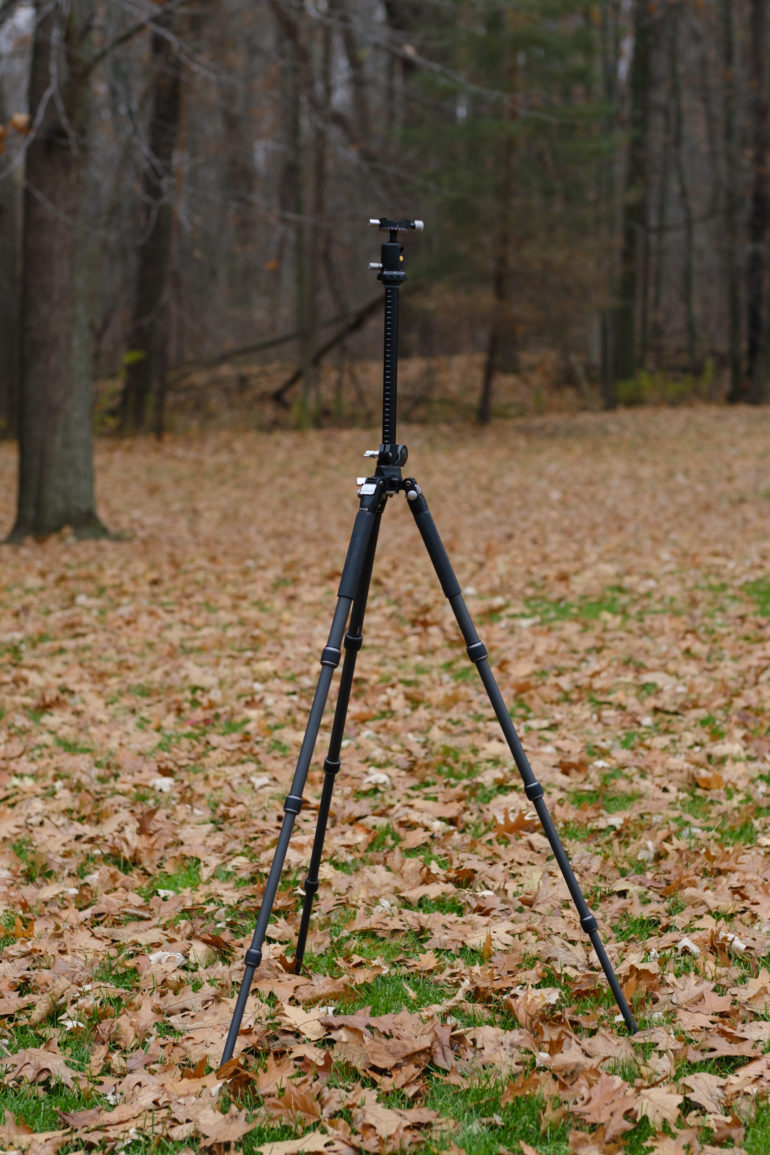
Pros and Cons
Pros
- Easy-to-use rotating center column for flat-lays and macro
- Accommodates a second camera with the center column in the horizontal position
- Tons of diagrams and levels for precision work
- Lightweight and compact
- Monopod option included
- Leg sections remove for cleaning
- Versatile
- Lightweight
- Port for an accessory arm (sold separately)
- Includes both rubber and spiked feet
- Includes a nice bag
Cons
- Requires 2-3 turns to tighten, which takes longer
- Counterweight is necessary when rotating the center column sideways or upside down
- Lots of dials and knobs can be confusing for newbies
Gear Used
I used the Vanguard Veo 3T+ 264CB Carbon with the Canon EOS R3 and the RF 70-200mm f/4 lens. I also tried it out with the Fujifilm X-T4 and XF 50mm f/1 R WR lens and the Canon EOS R6.
Tech Specs
Vanguard lists the following specifications for the Veo 3T+ 264CB:
- Full Extended Height: 61.42”
- Folded Height: 18.9”
- Included Head: VEO BH-160S
- Item Weight: 5.01 lbs.
- Leg Diameter (mm): 26 mm
- Leg Sections: 4
- Low-Angle Height: 6.69”
- Maximum Weight Load: 33 lbs.
- Monopod Folded Height: 35.24”
- Monopod Full Extended Height: 64.37”
- Quick Shoe: QS-62v3
- Standard Height: 51.57”
- Legs Material: Carbon Fiber
Ergonomics
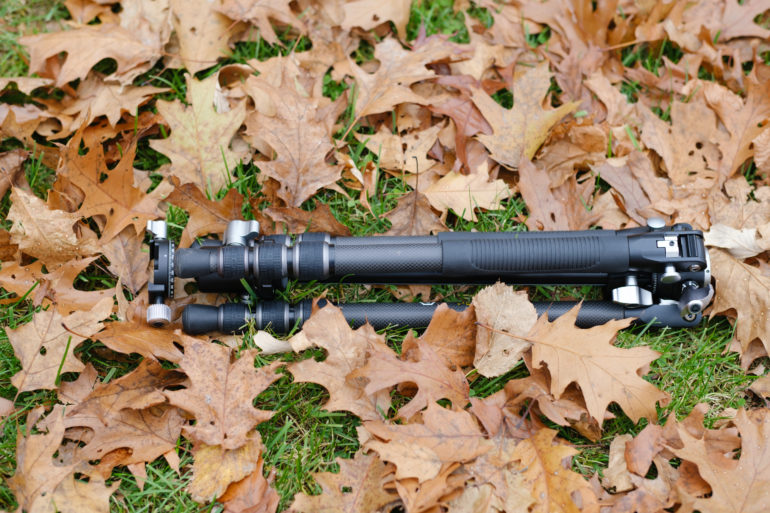
There are a few different variations in the 3T+ series. The Vanguard Veo 3T+ 264CB Carbon ships with a ball head included and has four carbon fiber leg sections, giving the tripod an overall height of just over 61 inches. The series is Vanguard’s travel-friendly option, but the 264CB is tricked out with a lot of extras, which make it a little heavier at about five pounds. It can, however, accommodate a maximum load of 33 pounds. I’ve used lighter travel tripods, and it’s actually about the weight of my aluminum travel tripod, but those lighter options don’t include that rotating center column.
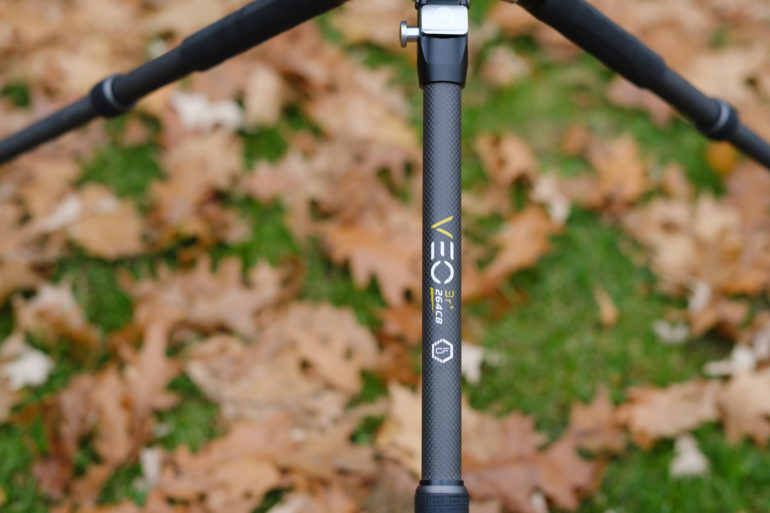
The legs are hollow carbon fiber. Each leg section can also twist completely off the tripod in order to clean the legs of any sand or debris build-up. One leg has a lock-unlock symbol at the top. This entire leg can twist off, then the entire center column can twist onto that to make a nice tall monopod. Two of the legs have a rubber grip at the top, which is much nicer than grabbing metal in freezing temperatures.
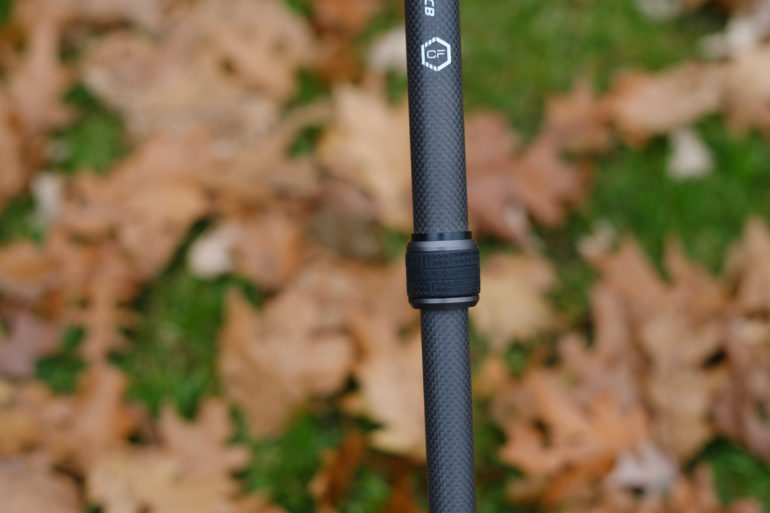
The Vanguard Veo 3T+ 264CB uses twist locks. Each lock has a nice rubber tire tread to it. The locks take two to three turns to fully tighten. The legs can be independently set at three different angles. A button at the side of each leg allows you to pull the leg to the desired angle.
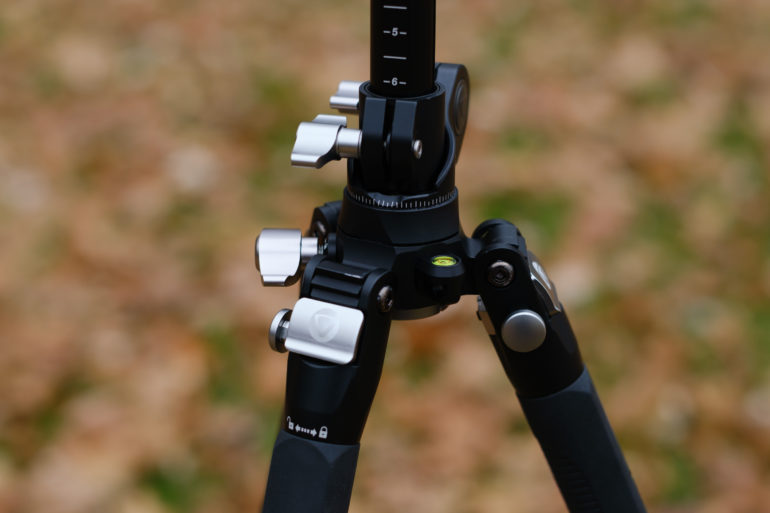
The legs are topped with a base that rotates with precise tick marks, as well as housing a bubble level. There’s also a port for screwing on an accessory arm (not included). The base cradles a center column that can be used traditionally. This center column housing, however, can also rotate to hold the center column horizontally, upside-down, or at different angles in between. This is great for shooting flat lays or shooting close to the ground.
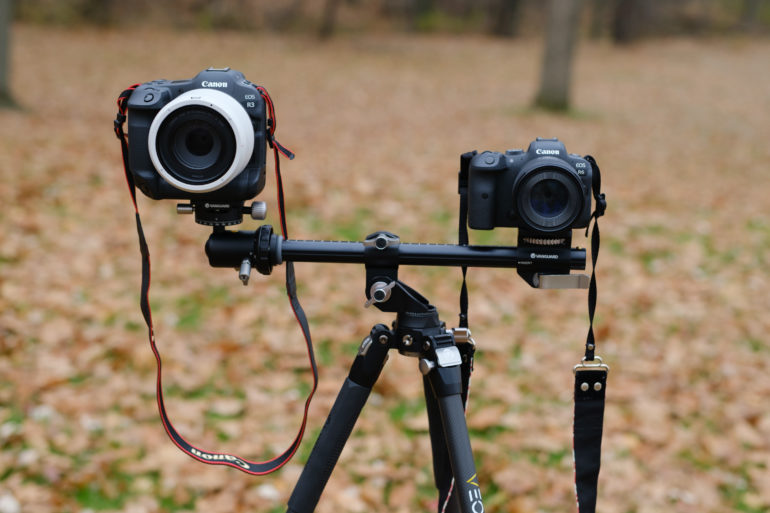
With the center column in the horizontal position, a second camera base can slide onto the open end, allowing the tripod to accommodate two cameras. Or, add anything that can screw into a tripod thread, like audio and lighting accessories. The counterweight hook does need to be removed in order to rotate the center column. But, if this is bothersome, the top of the legs has a hole that can accommodate a carabiner to add additional weight there.
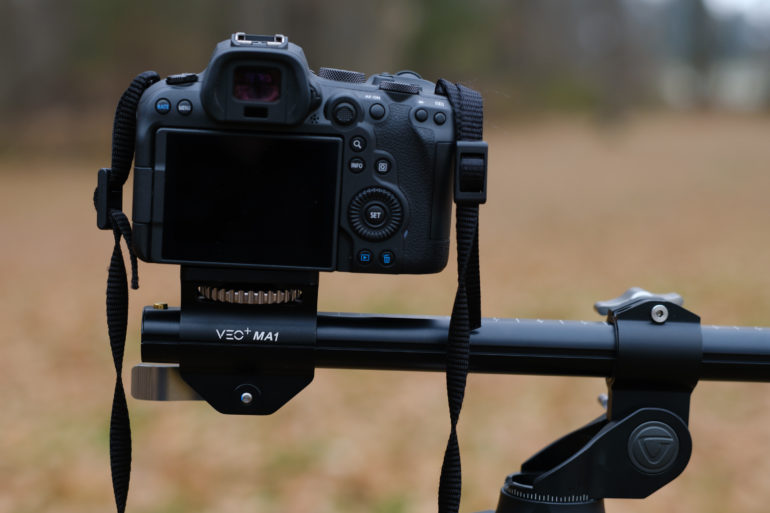
The tripod includes a ball head with a quick-release plate. The head includes another bubble level, as well as two different angle labels where the head can rotate in two different places. The second camera mount is the screw-in mount, with no quick plate (pictured above).
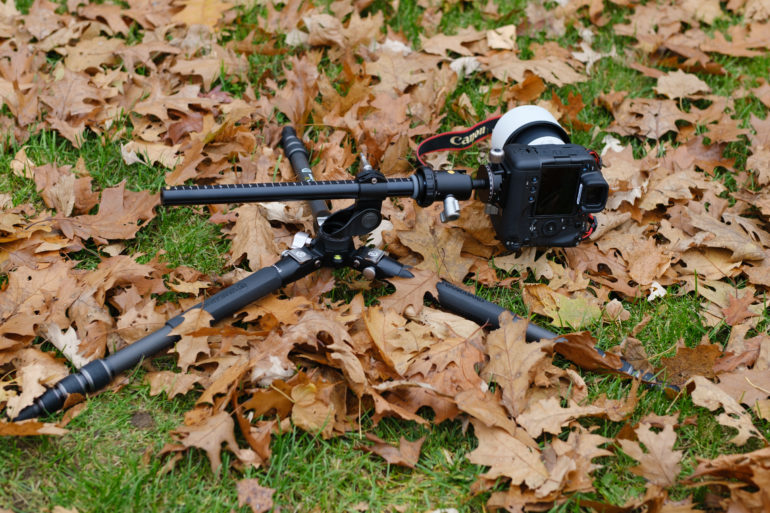
This design makes the Vanguard Veo 3T+ 264CB Carbon very versatile. The tripod can shoot macro low to the ground, flat lays, eye-level shots, and even odd angles with the rotating center column. Plus, you can shoot with two different cameras. I can’t think of anything that I would need a tripod for that I couldn’t use this Veo for.
Build Quality
The stability of the Vanguard Veo 3T+ 264CB Carbon is about what I would expect from a travel tripod. It’s pretty steady, but like most lightweight tripods, you may want a counterweight when shooting in windy conditions. Heavier tripods with fewer leg sections will be a little steadier — but they also won’t fit in a bag. This tripod is a good middle ground between stability and portability.
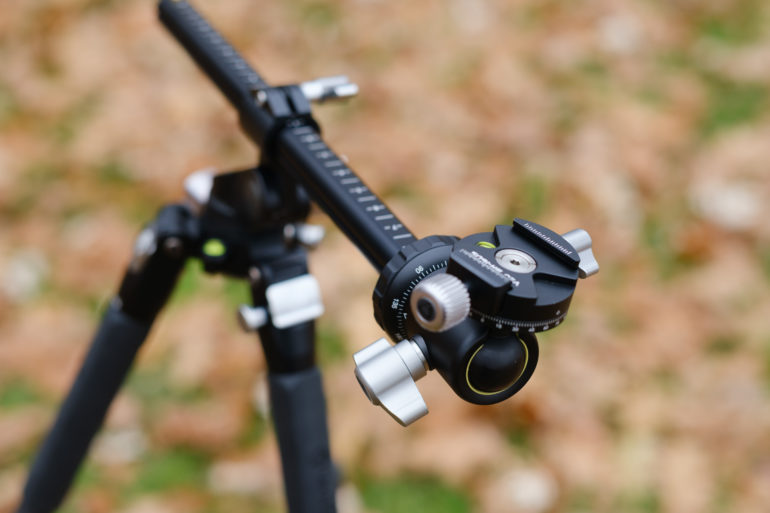
Indoors on flat ground, the tripod held the weight of the R3 and 70-200mm f/4 lens sideways without a counterweight. Outdoors on uneven grass, it needed a counterweight to prevent tipping towards the side of the camera. To be safe, I would hang my camera bag on the tripod when tilting the center column. The counterweight hook is large enough to hang a bag on, so you don’t need to carry extra weights. You can still add a counterweight with the center column horizontal by sliding a carabiner (not included) through a hole in the leg base. But, a large backpack won’t fit well in this position because the tripod legs are in the way. A smaller bag can work, however.
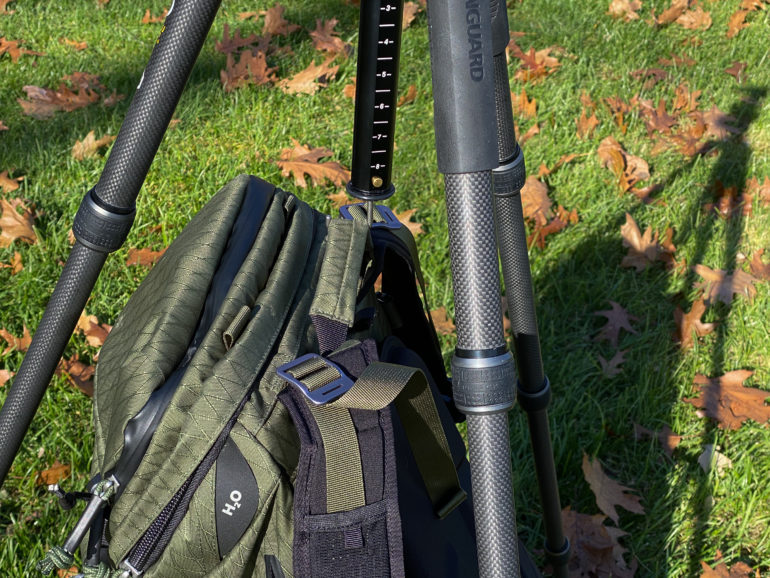
The tripod legs are hollow carbon fiber tubes. The legs feel like they use a little less material than the travel tripods that I’ve tried in the past. But, they still feel sturdy and that helps keep the weight down. The leg sections can also be removed. Cleaning the tubes after using the tripod in the sand should help extend the life of the tripod.
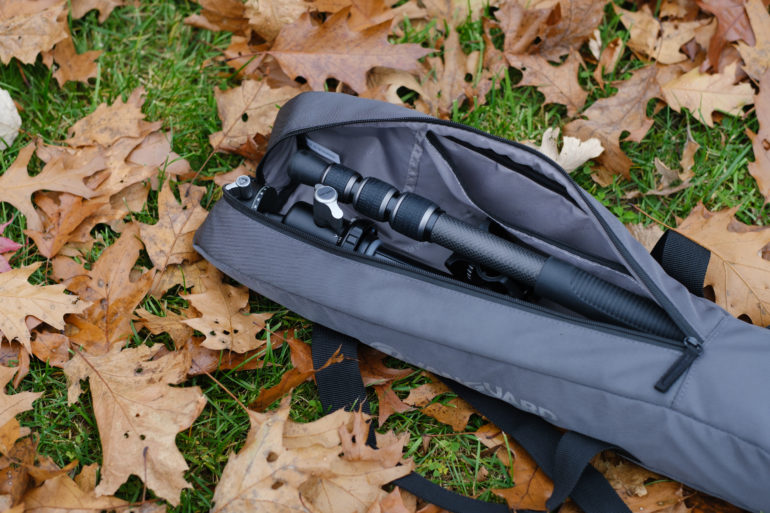
In short, the Vanguard Veo 3T+ 264CB Carbon is a lightweight but sturdy and durable tripod. You’ll get a bit more stability with a heavier studio tripod. But, for the category and with the option to easily add weight, it’s a good choice.
Ease of Use
This tripod feels like it was partially designed by NASA — both because it’s very precise and it is rather complex. There are a lot of knobs and dials on the tripod and included ball head. Seven, to be exact.
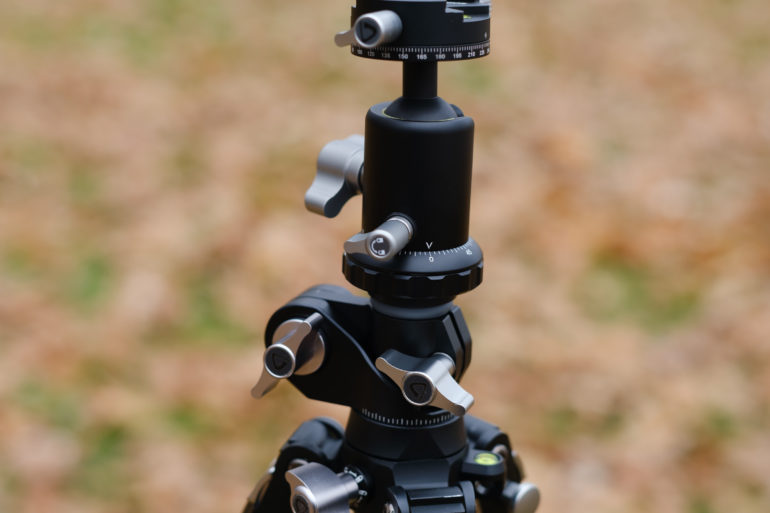
Three of those allow the camera to pan around. The first one the base rotates the center column on a scale of unlabeled tick marks. The second rotates the ball head completely around, with a 180-degree scale. The third sits just under the quick release plate and uses a 380-degree scale. This is great if you need precision, such as when shooting panoramas or a shot that you want to replicate later. But, if you’re a beginner just looking to capture some basic long exposures, it adds two unnecessary layers of confusion. For a tripod that’s priced more than $400, this is barely a concern. I don’t know many beginners that would reach for a tripod at this price point.
Two of those seven knobs adjust the center column. One tightens the position of the center column, which works in both the vertical and horizontal positions. In keeping with the NASA-precision theme, the center has tick marks in inches. The other knob activates the rotation of the center column itself, which only works if the column is fully extended. You can tighten that center column at an odd angle, or to get a 90-degree angle, match up two tick marks on the base.
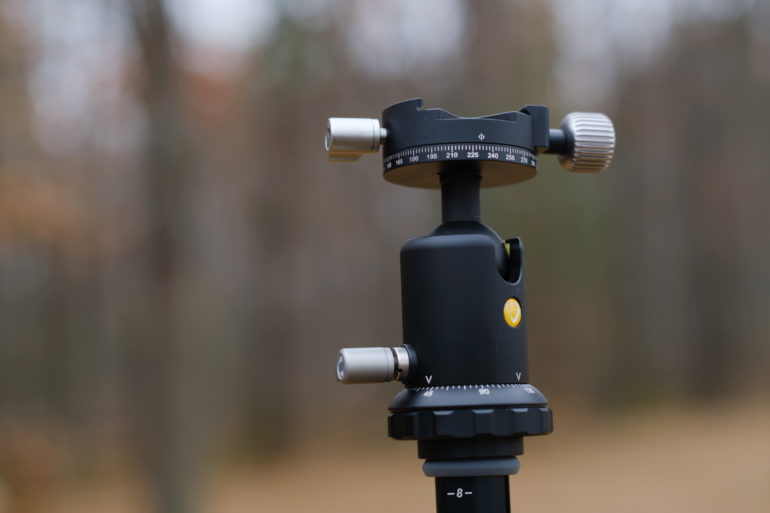
That leaves just two knobs left — one knob loosens the ball and adjusts the position of the camera there. The final knob tightens the quick mount plate onto the tripod.
I needed a bit of time to play with this tripod to figure out all its quirks and features. But, once I got accustomed to the different knobs and located features such as the monopod conversion, I was impressed with the versatility. I can do more with the Veo 3T+ than I could with any other tripod that I’ve used because of that rotating center column, option to add a second camera, and added precision features.
This tripod feels like it was partially designed by NASA — both because it’s very precise and it is rather complex.
Speed-wise, the Veo 3T+ sits in the middle of the road. The twist locks make it easy to deploy all the leg sections at once. But, it does take two to three turns to lock each one individually once extended. The leg angles adjust independently, which is a plus for versatility, but a minus for speed. The center column extends and rotates quickly, but you’ll need extra time if you need to remove and replace the counterweight hook. The quick plate is a screw-in type, not the quick lever, but held the R3 securely even sideways.
Conclusions
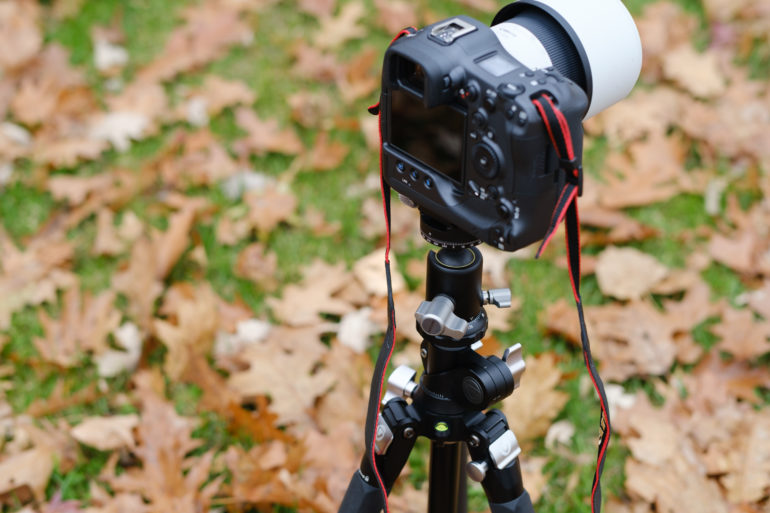
Likes
- The rotating center column is versatile and easy to use.
- You can mount two cameras with the center column in the horizontal position.
- There are lots of scales for precise angle adjustments.
- This can double as a monopod.
- You can twist off the leg sections for cleaning.
- There’s two ways to add counterweight and a port for attaching an accessory arm.
- The price includes both rubber and spiked feet, a second camera mount, and a nice bag.
Dislikes
- There are lighter carbon fiber tripods out there.
- It’s not super quick to set up.
- Counterweight is needed when rotating the camera on uneven ground.
- The amount of dials and knobs makes this tripod not ideal for beginners.
The Vanguard Veo 3T+ 264CB Carbon has the most versatile and precise adjustments that I’ve seen in a travel tripod. The rotating center column is easy to use and opens up additional possibilities for odd angles or even adding a second camera. There are a lot of extras, like an accessory arm and two different ways to add counterweights. It’s well built and even the bag that’s included is of nice quality.
That rotating center column adds a bit of weight, however. At about 5 pounds, it’s not overly heavy, but there are lighter options out there, particularly for carbon fiber. The twist locks tend to need 2-3 turns to tighten, so it’s also not the fastest to set up either. Rotating the center column with the R3 attached, I needed a counterweight on uneven ground.
If you need a tripod that’s both very precise and very versatile, yet small enough to hike with, the Vanguard Veo 3T+ 264CB Carbon is a great choice. However, if you don’t need that rotating column, you can save both some cash and some weight. And, in some scenarios, you’ll need to hook your camera bag on for added stability.

I’m giving the Vanguard Veo 3T+ 264CB Carbon four out of five stars. Want one? Check them out on Amazon.
[ad_2]






